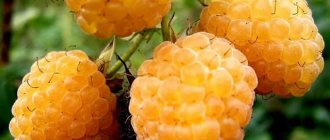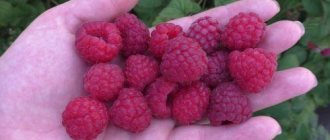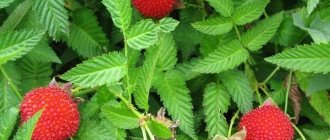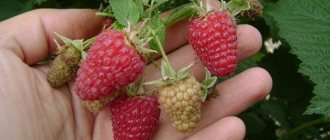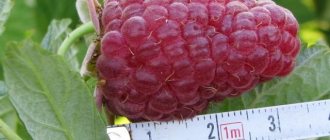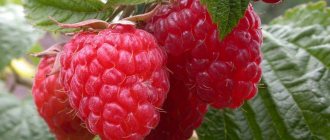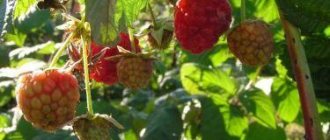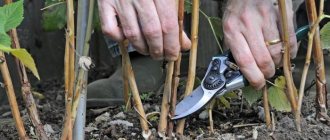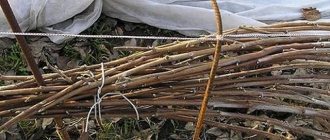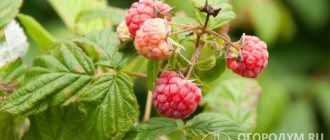History of creation and description of the variety
On the basis of the Kozhinsky breeding point (Bryansk region), which is under the jurisdiction of the All-Russian Selection and Technological Institute of Horticulture and Nursery Growing, a model of a raspberry variety ideally adapted to the conditions of central Russia was created. In accordance with the parameters of this model, including more than 30 traits, Doctor of Agricultural Sciences I. Kazakov and Candidate of Agricultural Sciences S. Evdokimenko created the Bryansk Divo variety in 2001. A remontant raspberry variety was obtained by interspecific crossing. Already in 2006, the Bryansk Divo variety was officially registered in the State Register and recommended for zoning.
The bush is powerful, erect, medium spreading
The bush of this variety is medium-sized, reaching a height of 1.5–1.7 m. Strong flexible shoots are covered with light brown skin. There are many medium-sized thorns on the shoots. The leaves are large, dark green in color, rough to the touch. The surface of the leaf blade is dry and wrinkled. The back side of the leaf has a whitish tint and is slightly pubescent. The flowers are white and reach 10 mm in diameter. They are collected in racemose inflorescences on the tips of the shoots and in the axils of the leaves. Raspberry flowers contain organic acids, vitamin C and tannins.
The weight of the dense and juicy raspberries of the Bryanskoye Divo reaches 11 g. The fruits have a clearly defined cone-shaped shape, their length is 3–4 cm. The scarlet berries have a pleasant sweet and sour taste and a light sweetish aroma.
The berries do not loosen or leak within 48 hours after picking
Chemical composition of berries:
- Carbohydrates (sugars): glucose - up to 4.3%, fructose - up to 8%, sucrose - up to 6.5%.
- Organic acids (citric, malic, formic, salicylic, caproic) – up to 2.2%.
- Vitamin C - up to 45%.
- Vitamins B1, B2, PP, A, E.
- Carotene - up to 0.3%.
The raspberry fruit is a polydrupe: the juicy pulp is concentrated around a small whitish seed. Raspberry pits (seeds) also have nutritional value, containing 22% fatty oils and about 0.7% phytosterol.
Tea made from dried raspberries has antiseptic and antipyretic properties; it is used in the treatment of colds and pulmonary diseases.
Variety Bryanskoe Miracle - video
Features of Bryansk Diva
Remontant varieties of berry crops are no longer new to the garden beds of domestic farms. Gardeners have been breeding them for more than a hundred years.
The long fruiting period - from August to mid-September (even after frosts down to -3 degrees you can harvest) attracts lovers of the Bryanskoye Divo raspberry variety.
This remontant miracle variety bears fruit throughout the entire growing season. The first harvest can be harvested already in mid-summer, as with conventional raspberry varieties. The second time the berries will ripen only on one-year-old shoots. For the sake of this late harvest, remontant raspberries are planted.
In addition, the Bryansk Miracle variety allows you to:
- reduce the time spent caring for raspberries (no spring and summer pruning of bushes);
- do not build high trellises for low-growing bushes;
- minimize the use of chemicals during the summer season, which has a positive effect on the quality of berries;
- solve the problem of frost resistance, because in the fall the shoots are completely cut out;
- do not cover the bush for the winter, because in the fall the shoots are cut out at ground level;
- During the autumn garden cleaning, completely clear the raspberry bed of old shoots and possible parasites that live on them.
Advantages and disadvantages of the variety - table
| Advantages | Flaws |
|
|
Advantages
- Early ripening, long fruiting, 90% of the harvest before frost, which is important when choosing raspberries for planting by residents of the northern regions.
- Good stable yield.
- Beautiful, spectacular berries with a memorable uniform shape (excellent presentation). And also their size itself - large and very large.
- Frost resistance down to -25°C, but this is rather relative. After all, there is no above-ground part; Bryanskoe Miracle is not suitable for obtaining a second harvest, like the Tutimera variety, and therefore there is nothing to freeze out - all the shoots are cut out at the end of the season, leaving only the most important thing for raspberries - the root system. Well, the root, protected by soil and covered with a layer of mulch for the winter, especially if the winter is snowy, is completely safe until spring.
- The habit of the bush is open, most of the fruits are not covered with leaves.
Planting remontant raspberries
Bryansk miracle raspberry seedlings grow and develop well in various climatic conditions, but you should not neglect planting advice.
Landing dates
Bryansk miracle raspberries can be planted in spring (late April - early May) or autumn (mid-September). You can focus on the ambient temperature (not higher than +10...+12 °C) and the condition of the soil (loose, the bayonet of the shovel fits freely and easily into the ground). Planting raspberries at higher air temperatures is not recommended, since there is a high probability of the soil and root system of the seedlings drying out.
Preparing the bed
Raspberries grow well and bear fruit in loose loamy soils with weak acidity. Field plants usually grow on such soils: coltsfoot, chamomile, field bindweed. Deep (from 2 m) underground water will ensure the formation of a healthy and strong root system.
The place for the garden bed should be quite sunny. It’s good if the sun hits the garden bed in the afternoon. Free access of air to the beds is also required. However, it is worth considering that raspberries do not like too open spaces. It is best to lay a bed along a fence or under the walls of outbuildings. The walls will protect the bushes from gusts of wind, and in snowy winters the snow will linger here, protecting the root buds from freezing.
Before preparing a bed for raspberries, a plot of land must be cleared of weeds. Particular care must be taken to destroy grass with a powerful creeping root system (for example, wheatgrass).
Weeds take away light, moisture, and nutrients from cultivated plants, so it is very important to remove them before planting raspberries
Selection of seedlings
Planting material should be purchased from local nurseries or specialized centers.
Criteria for healthy and strong planting material:
- Seedling height: no more than 0.7–1 meters.
- Quality and quantity of shoots: the presence of 2-3 flexible shoots covered with light brown skin.
- Root system: the presence of a flexible and moist skeletal root, 5–7 small roots.
During transportation, you should wrap the roots in a damp cloth and wrap them in plastic film, and after arriving at the site, remove the protection and bury the seedlings in damp soil.
When choosing raspberry seedlings, preference is given to strong, strong shoots with a developed root system
Step by step process
Raspberry bushes of the remontant variety Bryanskoye Divo are most effectively planted using the strip method.
- Dig trenches 15–30 cm deep (depending on the size of the root system of the seedlings).
- Complex fertilizer is evenly scattered over the trenches. For example, 10–16 g of superphosphate, urea, ammonium nitrate, 5–6 kg of rotted manure, 10 kg of peat compost and a liter jar of wood ash per 1 m².
- Mix fertilizers with the soil to prevent burning of the roots.
- Lay out the prepared planting material at a distance of 1 m from each other.
- A distance of 1.5–2 m is left between the trenches (rows of raspberries) - this is the row spacing zone.
- The seedlings are brought into a vertical position and sprinkled with earth.
- A small depression is made around the seedling so that water is better absorbed, and then the plant is watered (a bucket of water for one seedling).
- A circle around the plant is marked around the trunk (within a radius of 50 cm from the seedling), which is mulched with sawdust or dry grass with a layer of 10–15 cm.
- To prevent the appearance of overgrowth (especially in small areas), pieces of slate (iron, boards) are stuck into the ground at a distance of the trunk circle to a depth of 20–30 cm.
- After planting, raspberry seedlings are shortened to a length of 30–40 cm.
- At a distance of 5–10 cm from the row of seedlings, a series of sticks 50–100 cm high are stuck into the ground, to which the shoots are tied with twine - this will prevent the young plant from falling apart during wind or rain.
When planting raspberry seedlings, both deepening and protruding of the root collar is unacceptable.
Plant care
Caring for Bryansk marvel eliminates some agrotechnical techniques necessary when growing other raspberry varieties.
Watering
The Bryansk miracle has a powerful but shallow root system, so throughout the summer season (especially during the fruiting period) the plant needs abundant and regular watering. Under one bush you should pour 20–30 liters of water 1–2 times a day. Even after summer rains, which, as a rule, are short-lived and do not have time to wet the ground to a sufficient depth, it is necessary to water the raspberries.
It is best to water the bushes in the morning or evening to avoid burning the plant.
Treatment of row spacing and destruction of shoots
The superficial location of the raspberry root system eliminates digging and deep cultivation of the soil in the area around the tree trunk. However, loosening the soil and destroying all weeds should be carried out regularly (1-2 times a week).
When processing row spacing, raspberry shoots should also be destroyed at a distance of 20 cm from the shoot. If you do this 1-2 times a week, the shoots will not have time to take root, and it will be enough to chop off a section of the root by sticking a shovel next to the shoots.
Top dressing
- Twice during the season, with an interval of at least 14 days, raspberries are fed with a water infusion of manure (1:10) at the rate of 5–10 liters per bush.
- To improve the taste of the berries and increase the yield in the second half of July, it is recommended to add 100–200 g of wood ash under each raspberry bush.
Trimming
To trim shoots, use sharp garden pruners.
- After the beginning of the growing season and the formation of lateral branches, the lower lateral branches are cut off (before the ovary appears) to stimulate the growth and development of the upper lateral branches and larger berries.
- To obtain two harvests (summer and early autumn) in one season, not all shoots are cut out during autumn pruning. In some shoots, only that part of the shoot on which the ovary was located is cut off.
- To obtain an early autumn harvest, immediately after picking the berries, all shoots are cut down to ground level, leaving no stumps. In the southern regions of the country, spring pruning is recommended, since high temperatures last until mid-October, and pruned bushes can begin to grow.
Advantages of complete pruning of the remontant raspberry variety Bryansk Divo:
- maintaining fertile soil in the garden for a longer period;
- annual destruction of pests along with fruit-bearing shoots;
- annual rejuvenation of raspberries;
- a stronger raspberry bush, since a double harvest from one bush weakens the plant;
- harvesting the autumn harvest in full, since the summer raspberry harvest delays the ripening of the autumn harvest, which often goes under the snow, by 2-3 weeks;
- use of chemicals to kill pests in minimal doses;
- obtaining larger autumn raspberries compared to the fruits of the summer harvest;
- no problem of shoots freezing.
In autumn, remontant raspberries are pruned at the root, leaving no stumps.
Sanitary trimmings:
- In case of raspberry disease, the affected shoots are cut out.
- When the raspberries thicken (more than 5–7 shoots), the bush is thinned out, cutting out weak and poorly formed (unevenly developed) shoots.
In the case of complete autumn pruning of bushes, spring germination of the bush can be stimulated. In order for the development and formation of the raspberry bush to begin 2 weeks earlier, immediately after the snow melts, the pruned bush is covered with film. The film is removed after the shoots grow 10–15 cm.
If the gardener decides to get two harvests in one season (summer and autumn), then it is necessary to take measures to prevent the remaining shoots from freezing. Still flexible shoots at the end of September - beginning of October are tied into a bundle and bent to the ground. Cover them with available material (spruce branches, fallen leaves, quilted jackets). After a snowfall, they cover a bush covered with snow.
Pruning remontant raspberries - video
Reviews
I planted the Bryansk miracle in early November. In our region, we need to immediately build an irrigation system. I did it. Apart from this, I didn’t do anything else. The first berries began to appear in mid-July. The harvest turned out to be excellent. The raspberries, not having had time to grow, were already strewn with large, sweet berries. Now I have 10 bushes, next year I will try to increase the raspberry bushes.
The berries ripened from mid-August until frost. The crop began to form at the top of the raspberry bush, then gradually moved towards the base. When I began to pick off branches with buds from the base of the shoot, the berries on the main part of the branch became larger.
Bryansk miracle is now considered one of the most promising remontant raspberry varieties. It is capable of producing huge yields of large and beautiful fruits on relatively low bushes. Give this plant a little more attention and effort, and you will see this from the first year of cultivation.
Raspberry diseases
Remontant raspberry varieties are characterized by good disease resistance. But raspberry fields planted in areas with a problematic climate (northern regions or regions with high humidity) may require additional treatment and preventive measures.
Raspberry diseases and methods of combating them - table
| Disease | Description of the disease | Signs of defeat | Ways to fight | Processing periods | Preventive measures |
| Powdery mildew | A fungal disease whose spores are carried by wind or insects. | A faint whitish coating appears on the underside of the leaf blade, which spreads to the ovary. By the end of summer, damaged leaves become coarse and curl, and the coating turns into a brown-brown crust. Ripe berries are covered with a white coating and acquire a damp smell. | Drug Topaz (1 ampoule per 10 liters of water). Total consumption is 1–1.5 liters per 10 m². |
|
|
| Gray mold (botrytis) | A fungal disease, its spores overwinter in the bark or under the bark of raspberry shoots. Particularly common in areas or places with humid climates. | The appearance of gray spots on leaves and stems during the growing season, the appearance of brown spots on ripe berries. The spots quickly grow and become a gray velvety coating covering the berry. | Colloidal sulfur (100 g per 10 liters of water) or Bordeaux mixture. |
|
|
| Anthracnose | A fungal disease that affects weakened or damaged plants. Spread by wind, rain or insects. Most common in humid climates. | During the growing season, brown spots with a reddish border appear on the leaves and shoots. By September, these spots merge into a single large gray spot covering the surface of the shoot. The shoot cracks and dies, the ovary and unripe fruits fall off. | Topaz (1 ampoule per 10 liters of water) or Fitosporin (2–3 teaspoons of paste per 10 liters of water). Total consumption is 1–1.5 liters per 10 m². |
|
|
Raspberry diseases in the photo
As a rule, outbreaks of gray mold occur in years with damp and cold weather, and raspberries in dense areas are more affected
Powdery mildew can develop especially strongly in humid and warm weather.
Anthracnose is a widespread fungal disease that affects shoots, leaf blades and petioles, as well as raspberry fruits.
Flaws
- Bryanskoye Divo is very sensitive to interruptions in irrigation or simply insufficient watering. Heat and dry air and rain also have a bad effect on plants. The fruits become smaller and the taste deteriorates sharply.
- Under unfavorable weather conditions (high humidity and cool weather), the variety is one of the first among others to develop blight. By autumn it often happens that the bushes are completely stained. There is nothing particularly scary about this (unless, of course, you are selling seedlings); at the end of the season, the shoots are still cut to zero. But we must remember that any disease takes away the strength of the plant and this, accordingly, affects the yield. You also need to collect and dispose of fallen diseased leaves so that they do not rot in the soil, contaminating the soil. Therefore, it is advisable to pay special attention to the treatment of raspberries with systemic fungicides against fungal diseases.
- The berries are of medium density; transportation over long distances without refrigeration can be risky for the product. But for local markets this variety is just right - just by the look of the fruit, buyers are delighted.
- Very thorny shoots, which makes caring for plants and picking berries difficult. As some “authoritative” gardeners characterize this raspberry, it is a rather prickly variety with an average taste.
- And the main subject of controversy and the annoying weak point of Bryansk Div is its taste. It has no depth, fullness, or richness. Sweets are often not enough. In general, really average taste with no claims to stardom. Before tasting, from raspberries with such beautiful fruits, of course, you expect something completely different. In short, if you choose a variety for yourself to enjoy the berries on a small plot of land, you will be disappointed. But if the main task is to sell the harvest, then the Bryansk Miracle is quite suitable for you. And also, if there is free space, as a variety to replenish the raspberry collection, of course, it has a place!
Author: Maxim Zarechny.
Typical pests
According to the observations of amateur gardeners, remontant varieties of berry crops, which include the early autumn raspberry variety Bryanskoye Divo, are resistant to pests. However, under a certain set of unfavorable circumstances (prolonged heat or a prolonged period of heavy rains), even these varieties may be damaged by insects.
Raspberry pests and methods of controlling them - table
| Pest | Description | Signs of defeat | Ways to fight | Processing times | Preventive measures |
| Raspberry beetle | Gray-yellow beetles up to 4.5 mm long overwinter in the surface layers of the earth. When the soil warms up to +12..+13 °C, they crawl to the surface and feed on nectar and pollen of flowering weeds (without this food the beetles are not capable of laying eggs). Eggs are laid in the ovary and on the surface of raspberry leaves. | During raspberry budding, adult beetles gnaw out the buds and flowers, and during fruit set they lay eggs in them. The hatched larvae eat the fruits. The berries turn black, become small and wormy. |
Carry out two treatments with an interval of 4–5 days, but no later than 20 days before harvest. |
|
|
| Raspberry-strawberry weevil | Black beetles, 2–3 mm long, overwinter under last year’s leaves. After the earth and air warm up to +13 °C, young leaves crawl out and begin to destroy. After 6–8 weeks, the female beetles lay about fifty eggs in the buds, and dirty gray larvae emerge from the eggs. | Adult beetles lay eggs in the ovary. During flowering or even before flowering, the buds are completely eaten away. Beetles and larvae chew through the leaves. |
| Before flowering in dry, cool weather (morning or evening hours) at an air temperature of no more than +15 °C. |
|
| Raspberry stem fly | A gray fly up to 5 mm long, overwinters in the surface layers of the soil. In mid-April - mid-May, when the shoots reach 10–15 cm, it flies out and lays eggs in the axils of the upper leaves. | At the end of May - beginning of June, fly larvae, deposited in the axils of the upper leaves, eat up the tops of the shoots, causing them to dry out and die. | Trimming damaged shoots and tops. If the shoot is strong, you can treat it with Iskra (1 tablet per 10 liters of water), but the chemical method of combating this pest is ineffective. | During the growing season (mid-April - mid-May). |
|
Insect pests of raspberries in the photo
Berries damaged by the raspberry beetle become ugly, become smaller, wither and rot.
In early spring, the raspberry-strawberry weevil begins to feed on young raspberry tissues, gnawing through leaves, flower shoots and buds
Raspberry stem fly is a common dangerous pest of young raspberry shoots.
Reproduction
You can grow raspberries on your site in several ways: seedlings, root suckers and cuttings.
Propagation of remontant raspberries by cuttings
Since this raspberry produces very few offspring, it can be propagated by cuttings. The bush intended for cuttings is not removed in the fall. Cuttings are taken from its branches in the spring. To do this, select the middle part of the shoot with 4–5 buds.
The bottom cut of the cutting should be 1 cm below the bud.
The cuttings are placed in a liquid with a dissolved root former Heteroauxin or Kornevin for a day. After this, the prepared branches are placed in the holes and covered with loose, damp soil so that at least two buds appear on the surface. The top of the hole can be covered with a five-liter plastic bottle with a cut bottom and a screwed cap. It is best to organize a bed with seedlings in partial shade so that the bright sun does not damage the young leaves. You can also germinate cuttings in pots.
In early autumn, the grown seedlings are planted in a permanent place.
Cuttings of remontant raspberries can also be rooted in pots
Reproduction by shoots
You can propagate an existing raspberry bush using root suckers.
Video: propagation of raspberries by root shoots
Harvesting
By mid-August, the Bryanskoye Divo raspberries begin to ripen. At this time it is already possible to harvest. The fruiting period will last several weeks (until the onset of frost). From one bush you can collect up to 4 kg of berries.
Fruit ripening begins from top to bottom, from the top
Cut raspberry branches with unripe berries can be placed in a vessel with water. The berries will ripen and acquire a characteristic raspberry flavor.
Ripe fruits can be stored well on the bushes for 5 days, relieving gardeners of the need to pick every ripe berry. However, regular collection (once every 2-3 days) of ripe berries stimulates the ripening of green fruits.
Storage and use of berries
The dense structure of the Bryanskoye Divo raspberry allows the berries to maintain a cone-shaped shape and not spread within 48 hours after picking. For 2 days, raspberries can retain their taste and aroma in the refrigerator.
The shelf life of the berries can be extended. When frozen, the fruits are stored in the freezer for several months. Before freezing, raspberries are washed under running water and cleared of debris and sepals. 100–150 g of raspberries are placed in plastic boxes.
The berries of this variety do not have good transportability, but they can be transported in a special plastic container, packaged in 2–3 kg. Between the boxes you need to lay a shock-absorbing layer (corrugated or thick paper).
The berries of the Bryanskoye Divo variety are suitable for drying. Pre-washed fruits are dried in an oven or electric dryer at a temperature of +45…+50 °C. Dry berries are stored in clean glass jars or in linen bags at a temperature of no more than +20 °C for several months. Raspberry leaves are also dried and used to make delicious and medicinal tea.
Raspberries are ground with sugar, used for canning in assorted compotes, and aromatic and rich jams, preserves, and jellies are made.
Jams, jams, jellies and other preparations are prepared from Bryanskoye Divo raspberries.
